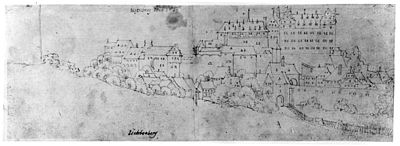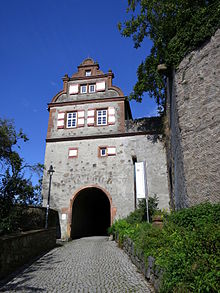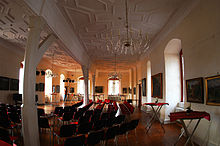Lichtenberg Castle (Hesse)
| Lichtenberg Castle | ||
|---|---|---|
|
The Lichtenberg Castle |
||
| Creation time : | 12th Century | |
| Geographical location | 49 ° 46 '21 " N , 8 ° 48' 35" E | |
| Height: | 278 m above sea level NHN | |
|
|
||
The Lichtenberg Castle lies in the South Hessian municipality Fischbachtal , in the district of Lichtenberg , in 278 m above sea level. Above sea level.
history


Lichtenberg Castle
Little is known about the origins of Lichtenberg Castle, which stood on the site of today's castle in the Middle Ages. Count Diether III. (Count von Katzenelnbogen between 1190 and 1214) married a Bertha von Lichtenberg, this could indicate an already existing castle in Lichtenberg. The first mention of Lichtenberg is assumed for the year 1228 today: Count Diether IV. Of Katzenelnbogen called on the district court in Heppenheim still comes (Count) de Lichtenberg . It is generally assumed that it was built around 1200. It is also assumed that the castle was built before 1254 by Count Diether IV von Katzenelnbogen. Survived is a document of 1295, in which the Count Palatine Rudolf as a feudal lord the Count Wilhelm of Katzenelnbogen with accessories his wife Irmengard than allowed, the castle Lichtenberg dowry to leave.
The count palatine owned the upper bailiff's rights in the Lorsch monastery , whose possessions also extended over the area of the later office of Lichtenberg. When the imperial monastery was subordinated to the Archdiocese of Mainz in 1232 by Emperor Friedrich II , this constellation developed into serious conflicts. These disputes could not be settled until the beginning of the 14th century through a contract in which the possessions of the monastery were divided between Kurmainz and Electoral Palatinate and the bailiwick rights of the Count Palatine were confirmed. The Palatinate feudal rule did not end until 1803 with the dissolution of the Electoral Palatinate by the Reichsdeputationshauptschluss . During its greatest expansion, the County of Katzenelnbogen was divided into two main areas: the so-called Lower Counties around Katzenelnbogen and Rheinfels Castle and the so-called Upper Counties around Darmstadt , which also included Lichtenberg Castle.
Parts of Hausen (today Oberhausen ) also belonged to the area of the Lichtenberg Castle Freedom , which included the place Lichtenberg . In the 14th century, the Counts of Sponheim owned the castle as a Palatinate fief for several decades. From 1398 belehnte Palatine Ruprecht again the Eberhard V with castle and town Lichtenberg along with villages Biberaw and Husen ... (Bieberau and Hausen)
Lichtenberg Castle was also mentioned, among other things, when Count Dieter received the Lichtenberg Castle and the town of Reinheim in the Katzenelnbogischen inheritance of 1300 , while the associated rights and inclines were shared with his Count Wilhelm . In 1312 Emperor Heinrich VII gave his faithful Count Diether VI. Von Katzenelnbogen as a reliable supporter of the empire for the loyal service rendered to him and the empire in Italy, the grace that his Lichtenberg castle with the town of Bieberau below it and all its inhabitants should enjoy the rights of town and citizens to Oppenheim due to his imperial authority. He gave the town of Bieberau a weekly market to be held on Tuesday, the visitors of which were under his protection and that of market freedom. The emperor also allowed the count to keep twelve Jews in Lichtenberg-Bieberau.
Pfalzgraf Adolf allowed in 1323 to Count Diether VII. Of Katzenelnbogen to his wife Catherine to the castle Lichtenberg and the adjacent part of the county Katzenelnbogen he wore from him as a fief, bewittumen . At that time his mother Katharina von Kleve lived in Lichtenberg as her Wittum, which subsequently led to the loss of the castle for the Katzenelnbogen family . Only in 1393 did it return to the von Katzenelnbogen family after the death of Heinrich von Sponheim.
In 1360, Emperor Karl IV granted Count Heinrich von Sponheim, married to Adelheid von Katzenelnbogen, the rights to the town of Lindenfels and a weekly market for the castle and town of Lichtenberg .
Count Johann IV von Katzenelnbogen promised his wife Anna in 1398 that he would weather her on half of Lichtenberg with accessories that he owned as a pledge, after his father Count Diether VIII had promised her.
In 1422, Count Philipp von Katzenelnbogen wrote to Schenk Konrad the Elder, Herr zu Erbach , and Hans Kämmerer the Elder, that they and their fellow riders had pillaged Bieberau and other villages belonging to Lichtenberg and had caused it great damage.
After the death of the last Count of Katzenelnbogen, Philipp I , in 1479, the Landgraves of Hesse inherited his property and Lichtenberg Castle. The construction of an upstream bulwark in 1503 served for better defense. The bulwark can still be visited.
Lichtenberg Castle
In 1570, the master stonemason Jakob Kesselhuth from Kassel began to convert the castle into a palace on behalf of Landgrave Georg I of Hessen-Darmstadt . Only the Katzenelnbogen building and the eastern outer wall remained of the former upper castle. The latter was retained as the outer wall of the newly built east wing. Remains of old window openings are still visible in the castle chapel. Lichtenberg was the first Renaissance castle in the southern Hessian area and thus served as a model for other buildings in the region (for example the castle in Darmstadt ).
Because of the "healthy air", the landgrave family liked to stay in Lichtenberg. The castle became the starting point for the hunt and at times also the widow's seat of the landgraveesses.
During the Thirty Years' War , the Landgrave family temporarily resided in Lichtenberg to protect against armies and the rampant plague in Darmstadt. Lichtenberg Castle and Fortress were never captured during the Thirty Years War, only the supplies had to be "brought out" to opponents. Most of the villages in the Fischbach valley were deserted due to attacks and epidemics after the end of the war.
The Hessian landgraves and their families lived in the palace complex less and less in the following period. The castle and its territory was administered from 1315 to 1749 by a burgrave with the rank of court official who was also entrusted with the castle guard . The burgrave's official residence was a house directly owned by the princely. A total of four of the Burgraves of Lichtenberg were provided by the Boßler family from 1677 to 1749 . The castle freedom and the castle peace district had the high jurisdiction .
The Katzenelnbogen building (former north wing and what remained of the former castle complex in the area of the upper castle) collapsed in 1845 after being severely damaged in a storm days earlier. The half-timbered building was largely demolished and today's palace terrace was built in its place. The foundations of the building are still in place under the palace terrace. They were temporarily exposed in 2010 and examined by archaeologists from the State Office for Monument Preservation . Since the building was demolished, the upper castle has had its horseshoe shape, which is now widely visible. The connecting doors leading from the west wing to the former north wing were still there until the beginning of the twentieth century and are still visible on older paintings and photos. They were probably closed in 1910 when the castle hotel, which had now been established, was being expanded.
View by Matthäus Merian 1655.
Todays use
The castle belongs to the State of Hesse and is administered by the Hessian Real Estate Management. Part of the palace has been rented by private individuals for residential purposes since the 1950s. Visitors to Lichtenberg Castle can, by prior arrangement, visit the local history museum in the east wing, which is operated by the Fischbachtal community, as part of a guided tour . The exhibition of the Bergstrasse-Odenwald Geopark and the famous rocking horse and tin figure collections are worth seeing . The Kaisersaal in the south wing is attached to the museum and impresses with the permanent exhibition of the painter Johannes Lippmann and the earthen stucco ceiling, which was faithfully restored in the 1990s. Due to its good acoustics, the Kaisersaal is also the venue for the Lichtenberg Palace Concerts.
The historical lecture room on the ground floor of the west wing is available for private celebrations. Under tight conditions it is also possible to reserve the Kaisersaal for larger groups.
The outer bailey with stables and tithe barn , located below the upper castle, is the oldest and most historically significant part of the complex, but is not open to the public. It houses storage areas for the tenants.
The so-called Schlosspark and Rentheygarten also belong to the extensive grounds. The latter is a magnet for visitors, especially in the summer months, as it is then served as a beer garden by a local specialty restaurant. From this position you can see large parts of the front Odenwald (including the Neunkirchner Höhe) and the Fischbachtal. The "Christkindlshaus", a former watchtower, is also located in Rentheygarten, where Christmas events for children are regularly held during Advent.
The former castle park connects the villages of Niedernhausen and Obernhausen with Lichtenberg Castle via numerous hiking trails. Numerous dry stone walls can still be seen in it , the remains of old vineyards below the castle. Old awards also bear witness to a formerly built arboretum . The castle park is heavily forested and currently offers few attractions for visitors. The state of Hesse is currently working on restoring the palace gardens to a historically appealing state. The visual links between Reinheim and Groß-Bieberau and the castle were restored in February 2013. Further work is to follow in autumn 2013.
At the instigation of the Hessian Real Estate Management, the palace chapel on the ground floor of the east wing was renovated according to the historical model. The management of the State Palaces and Gardens of Hesse was responsible for the preservation of monuments . Numerous details that have been lost since the Second World War (such as the old pulpit staircase and wall paintings) have been restored. The castle chapel was opened to the public again on August 29, 2010 as part of an ecumenical service.
In a second construction phase, the Hessian Real Estate Management and the administration of the State Palaces and Gardens of Hesse had the renovation and conversion of a former apartment on the ground floor of the south wing, which until 1848 housed parts of the Lichtenberg Regional Court, into a registry office. The monument preservation investigations also brought numerous historical findings to light in these rooms, hidden under modern wall plaster and wallpaper, which have been accessible to the public again since the ceremonial handover of the rooms to the Fischbachtal community on September 15, 2011. Among other things, Renaissance wall and ceiling decorations as well as old half-timbered walls and floor coverings were restored. The work for this took a year. Since the summer of 2012, visitors to the palace have also been able to visit the newly created Renaissance garden in front of the south wing. Since there were no historical records of this garden and it can be reached via a small staircase from the former castle kitchen, it was laid out as a presumable supply garden for the castle in the style of a Mediterranean herb garden from the Renaissance period.
Guided tours on the subject of Lichtenberg Castle and Bollwerk are offered by the on-site guides at Fischbachtal.
Regular events
- November / December: Advent market
literature
- Johannes Feick: Lichtenberg in the Odenwald in the past and present - described according to the sources. Volume 2, Kommissionsverlag Saeng, Darmstadt 1903, ( OCLC 179967333 ).
- Thomas Biller: Castles and palaces in the Odenwald. A guide to history and architecture. Schnell and Steiner, Regensburg 2005, ISBN 3-7954-1711-2 , pp. 206-210.
- C. Bronner: Odenwaldburgen. Verlag von Karl Zibulski, bookstore, Groß-Umstadt 1924.
- Rudolf Knappe: Medieval castles in Hessen. 800 castles, castle ruins and fortifications. 3. Edition. Wartberg Verlag , Gudensberg-Gleichen 2000, ISBN 3-86134-228-6 , p. 538.
- Thomas Steinmetz: Castles in the Odenwald. Verlag Ellen Schmid, Brensbach 1998, ISBN 3-931529-02-9 , p. 69.
- Hans H. Weber: On the building history and history of Lichtenberg Castle in the Odenwald. In: The Odenwald. Zeitschrift des Breuberg-Bundes 29/1, 1982, pp. 3-15.
- Winfried Wackerfuß : Valentin Wagner's views of Rodenstein Castle and Lichtenberg Castle in the Odenwald as sources of architectural history. In: Holger Th. Gräf and Helga Meise (eds.): Valentin Wagner. A draftsman in the Thirty Years War. Exhibition catalog Hessisches Landesmuseum Darmstadt 2003, ISBN 3-921254-92-2 , pp. 83–94.
- Rolf Müller (Ed.): Palaces, castles, old walls. Published by the Hessendienst der Staatskanzlei, Wiesbaden 1990, ISBN 3-89214-017-0 , pp. 112–115.
Web links
- "Lichtenberg Castle, Darmstadt-Dieburg District". Historical local dictionary for Hessen. In: Landesgeschichtliches Informationssystem Hessen (LAGIS).
- Private page to Fischbachtal
- www.schloss-lichtenberg.info
- www.schloss-lichtenberg.de
- Renaissance castles in Hesse (project at the Germanic National Museum by Georg Ulrich Großmann )
Individual evidence
- ↑ Map services of the Federal Agency for Nature Conservation ( information )
- ↑ Johannes Feick: Lichtenberg in the Odenwald in the past and present - described according to the sources . tape 2 . Commission publisher Ludwig Saeng, Darmstadt 1903, OCLC 179967333 , p. 114-115, 117 .
- ↑ Hans H. Weber: The castle freedom Lichtenberg - a contribution to the problem of the late medieval city in the Odenwald . Ed .: Winfried Wackerfuß on behalf of the Breuberg Association. Reprint from Volume III - Contributions to the exploration of the Odenwald and its peripheral landscapes. Breuberg-Neustadt 1980, OCLC 888480865 , p. 127-131 .
- ↑ a b City of Lichtenberg? In: Website of the Fischbachtal community. Accessed February 2020 .
- ^ Wilhelm Müller: Hessian place names book: Starkenburg . Ed .: Historical Commission for the People's State of Hesse. tape 1 . Self-published, Darmstadt 1937, DNB 366995820 , OCLC 614375103 , p. 428 ff .
- ^ Website Fischbachtal-Bollwerk
- ^ Website Fischbachtal - Thirty Years War
- ↑ Johannes Feick: Lichtenberg in the Odenwald in the past and present - described according to the sources . tape 2 . Commission publisher Ludwig Saeng, Darmstadt 1903, OCLC 179967333 , p. 80, 106 .
- ↑ Hans H. Weber: The castle freedom Lichtenberg - a contribution to the problem of the late medieval city in the Odenwald . Ed .: Winfried Wackerfuß on behalf of the Breuberg Association. Reprint from Volume III - Contributions to the exploration of the Odenwald and its peripheral landscapes. Breuberg-Neustadt 1980, OCLC 888480865 , p. 127-142 .
- ↑ Fischbachtal community
- ↑ Restaurant "Alt Lichtenberg"
- ↑ Festschrift for the 75th anniversary of the Dieburg District Court, page 56
- ↑ About us . In: Geopark-on-site guide Fischbachtal . November 9, 2016 ( geopark-fischbachtal.org [accessed June 5, 2017]).
- ↑ Darmstädter Echo , Thursday, November 26, 2015, p. 20















